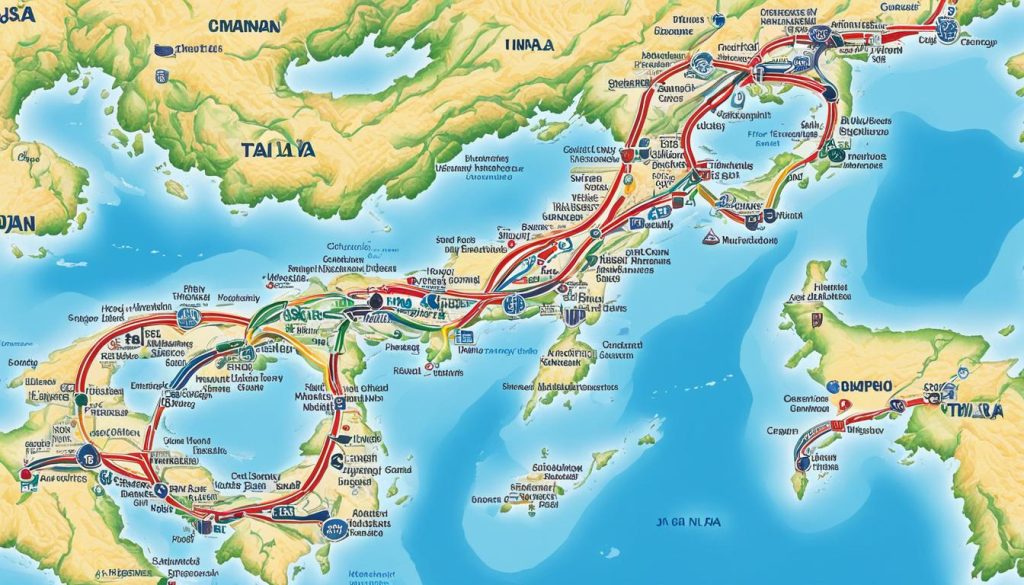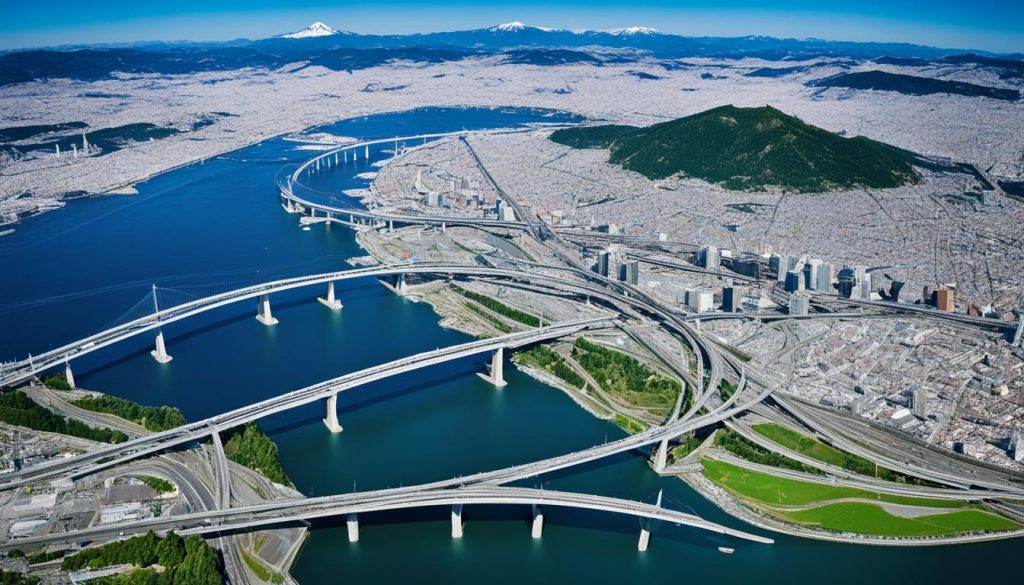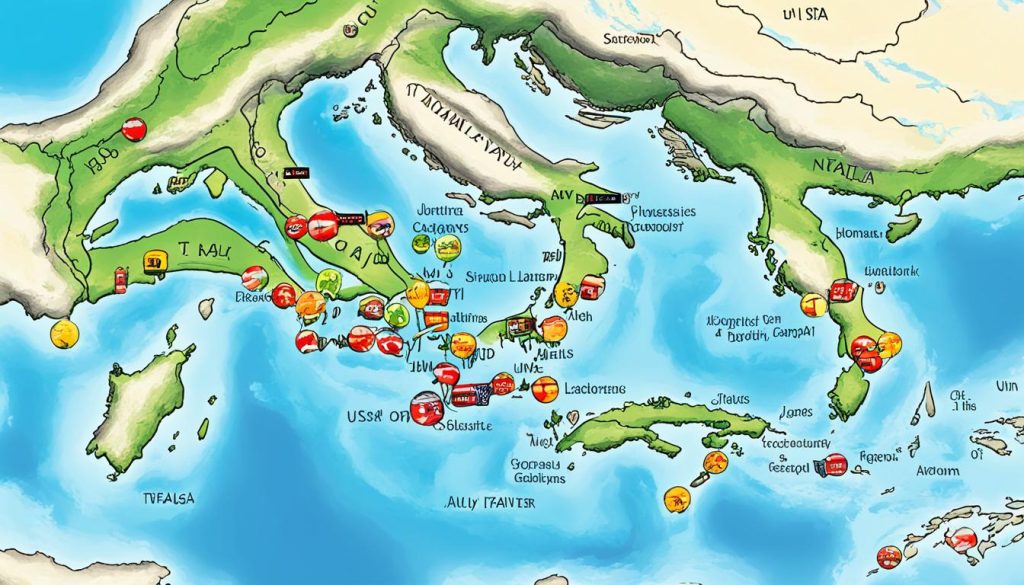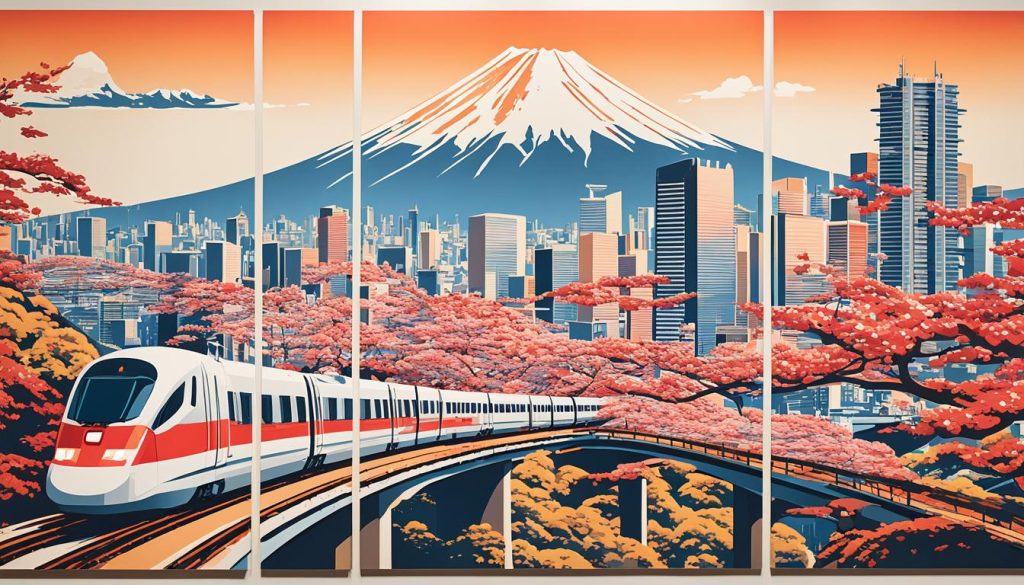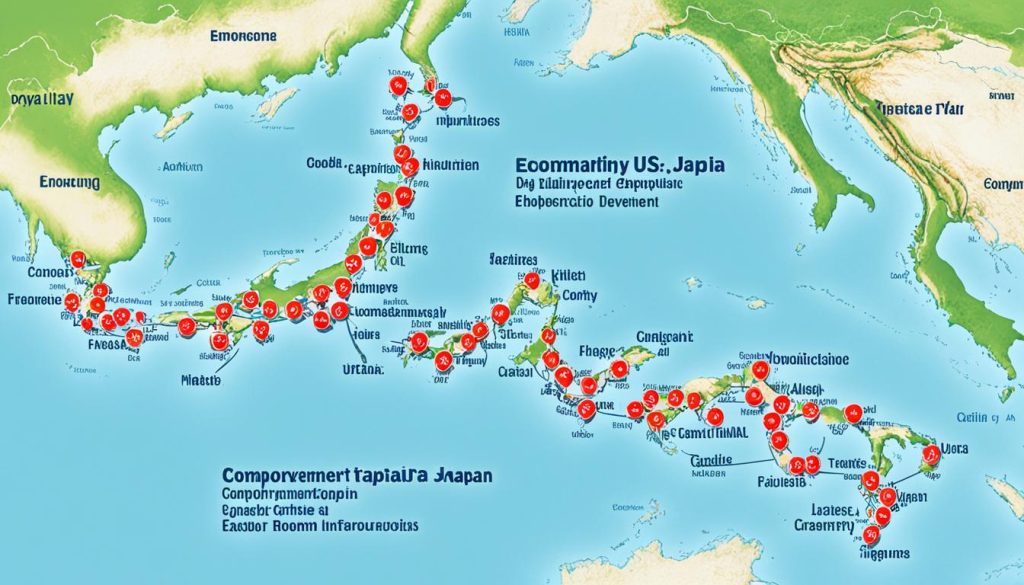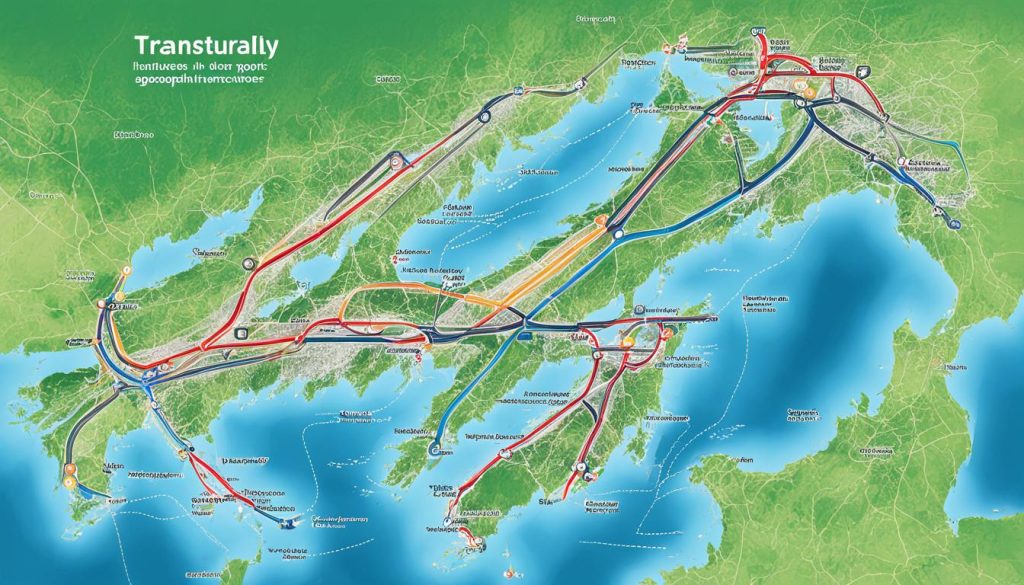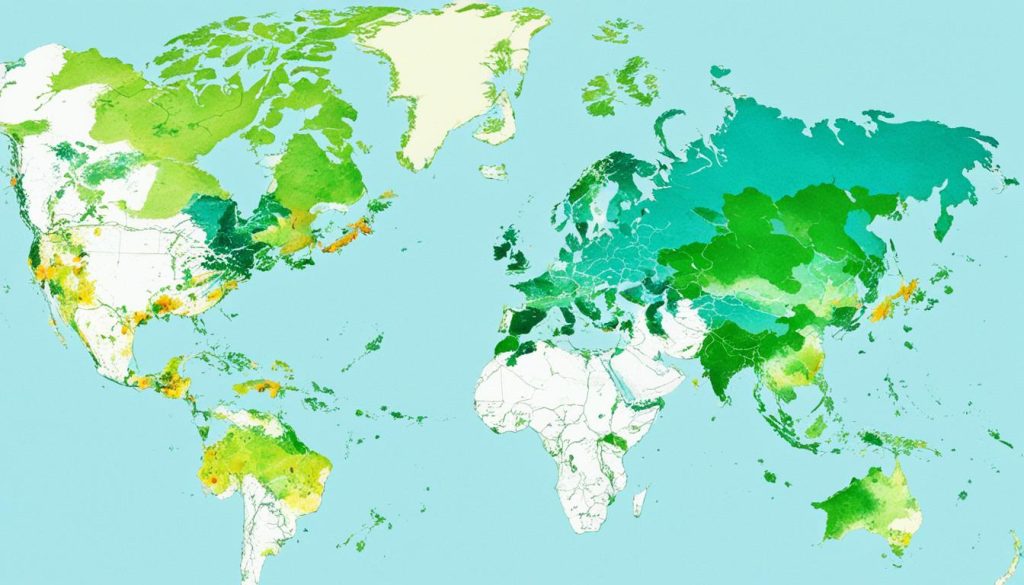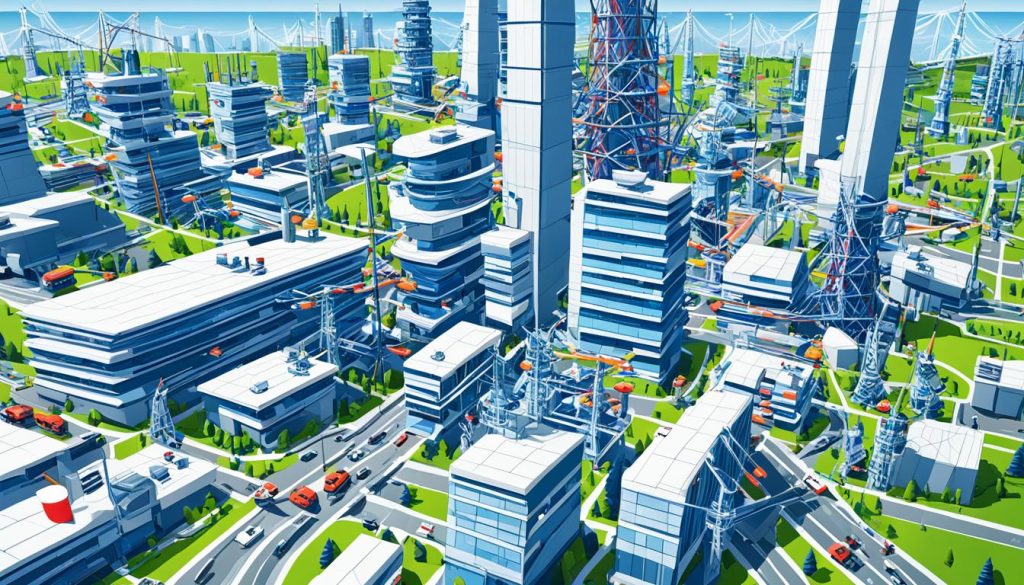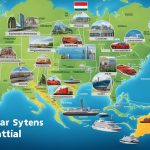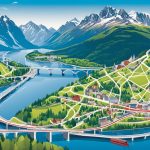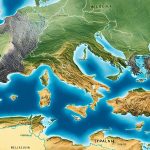We explore the landscapes and infrastructure of Japan, Italy, and the USA. Each nation showcases its identity through its unique geography and construction. Japan’s islands in East Asia and Italy’s boot-shaped peninsula in the Mediterranean are unique. They both differ from the vast USA. Through comparing these countries, we notice their distinct geographies and how their infrastructure supports them.
Introduction to Comparative Analysis
We are starting a journey to compare different countries. Our aim is to deeply understand nation comparison data by exploring country profiles. Our analysis goes beyond simple numbers. It offers insights into the geography, infrastructure, population, and laws of Japan, Italy, and the USA.
We don’t just look at basic facts. Our goal is to discover the deeper aspects of governance and society in these countries. We carefully selected up-to-date data. This includes information on population, life expectancy, and economic strength.
- Geographical Disposition: We compare each country’s geography and environment. This helps us understand each nation’s unique natural resources and landscape.
- Demographic Distribution: We examine the population statistics. This shows us the cultural and social diversity of each country.
- Infrastructural Evaluation: We explore the infrastructure supporting daily life. We look at transport, communication, and public services. This gives us insight into each country’s development.
Our detailed analysis highlights the variety of landscapes and lifestyles across countries. We learn to appreciate the unique qualities of different places. Our study shows how interconnected we are in the world.
Geographical Expanse and Distribution
Exploring Japan, Italy, and the USA showcases fascinating regional and topographical differences. Japan is made up of islands in East Asia. The USA covers broad parts of North America. Italy looks like a boot and sits in Southern Europe. Each place stands out globally due to its unique traits.
Area and Regional Positioning
The USA and Japan show the variety in land sizes. The USA stretches across North America with different climates. Japan’s islands lie off the coast of East Asia. Although smaller, Italy’s position in the Mediterranean also stands out.
Topographical Features
The landscapes of these countries add to their character. Japan has mountains and few flat areas for farming. The US has deserts, plains, and high mountains. Italy is known for its mountains and beautiful coastlines.
Geography affects climate, resources, and how societies develop. It shapes infrastructure and cultural lifestyles. Understanding this helps us see how each place has its unique charm and challenges.
Population Dynamics and Urbanisation
When we talk about how societies are built, we can’t ignore the impact of demographic trends. Looking at Japan, we see a place with many people living close together. This situation is a result of its past and current events. Tokyo is a prime example, where people live among tall buildings and busy streets. This scene is quite different from the USA. There, people are spread out over a large area thanks to the country’s size.
In Italy, tradition and modernity blend seamlessly. Its urban areas are rich in history but embrace new developments too. The rate of urbanisation in Japan, the USA, and Italy highlights the different directions they’re taking towards city living.
- Japan is moving quickly into the future with its city-focused lifestyle.
- The USA shows a mix of fast-developing cities and quiet, spread-out suburbs.
- Italy mixes old-world charm with modern urban design.
Demographic trends tell us more than just numbers. They show the strengths, challenges, and cultural values of each country. Japan is known for its order, the USA for innovation, and Italy for keeping its history alive. These elements show how each country is growing and changing.
Comparing Government Forms and Political Stability
In the political worlds of Japan, the United States, and Italy, it’s clear that the strength and function of their governments play a big role in their growth and global standing. By looking at their government systems, we can see how different laws and democracy levels shape their societies. Let’s examine the government structures and signs of political steadiness that make these countries stand out.
Governmental Structures
Japan, the United States, and Italy all follow democratic ideas, but their constitutions are quite different. Japan combines its historical monarchy with parliamentary governance, making a special kind of government. The US is known for its strict division of powers, with checks and balances among its branches. Italy, focusing on unitary government, centres power around the Prime Minister and Parliament. This contrasts with the US’s decentralized approach.
Indicators of Political Stability
- Political Stability Comparison: Japan and the US often get high marks for political stability, thanks to their old, strong democracies and focus on civil freedoms.
- Democracy Measures: Japan does especially well in democracy measures like civil rights, blending respect for tradition with freedom.
- Civil Governance: Effective civil governance has helped Japan and the US stay flexible and strong in their politics.
- Government Changes: Italy, dealing with more government changes, faces challenges that need deep political analysis for policy-making and international relations.
Studying these government systems offers deep insights into each nation’s political stability and democratic health. Looking at civil rights, governance effectiveness, and constitutional stability gives us a full picture of these democracies’ strengths.
Analyzing Quality of Life Across Countries
Looking at the quality of life index across continents reveals a lot about well-being in Japan, Italy, and the USA. People in these countries see life quality differently, thanks to healthcare, living costs, and climate. These factors play a big role in their happiness.
In Japan, folks praise their healthcare for being efficient and easy to get to. Yet, living in big cities like Tokyo can be expensive, which makes life harder. Also, Japan’s harsh weather can really affect people’s comfort and day-to-day life.
The USA has many different climates that people like, which boosts happiness in various places. However, its healthcare system, despite being advanced, is often hard to access and expensive. Recent issues in political stability add more to the complexity of its life quality.
Italy’s rich cultural background and lovely Mediterranean weather make its citizens happy. But, Italy also deals with political changes and healthcare challenges. These issues are important when talking about well-being.
To wrap up, knowing what affects the quality of life is key to understanding well-being in different countries. Japan, Italy, and the USA all have their own strengths and problems. These aspects show how complex it is to make life quality better nationwide.
Economic Indicators: Income, Employment and Trade
Looking at the economic success of Japan, Italy, and the USA is quite interesting. We see GDP and GNP figures, trade balance details, and data on income and jobs. These factors show how healthy each economy is at the moment. They also hint at what might happen in the future for these top players in the world economy.
GDP and GNP Insights
The USA leads the way in GDP and GNP, showcasing its massive economic impact worldwide. Japan also impresses with strong growth numbers, despite having a lot of national debt. Italy stands out in Europe with an economy that matches its role in the EU market.
Employment and Average Incomes
Japan has a very low jobless rate, which points to a thriving job market. But, average incomes there are not as high as the big salaries in the USA. This difference sheds light on the living standards and economic levels in each country.
Trade Balance: Exports and Imports
A look at trade balance shows the complex web of world economic ties. Both Japan and the USA are giants in trade, buying and selling huge amounts of products and services. Their trade activities are crucial in driving global market trends and supply chains.
Comparative Infrastructure: Roads, Railways and Airports
Looking into a country’s infrastructure tells us a lot about its fast movement and trade abilities. Japan is known for its top-notch rail system. This system suits its land shape well. Even though Japan isn’t very big, it has many highways, railways, and airports. These connect busy cities to far-off areas. Japan’s transport cleanliness and on-time service show its culture’s focus on order and respect for public facilities.
In the huge area of the United States, the transport situation is quite different. It has the most roadways and railways in the world. These networks are made for long journeys across diverse lands and weather. The U.S. also has many airports for both local and global flights. This shows its strong position in world transport and logistics.
Italy’s infrastructure also stands out, though we don’t have many details. It has beautiful highways cutting through lovely scenes. Italy mixes historical charm with modern transport needs well. Its railways link big cities, and small airports help with tourism and business. Italy’s system might not match the U.S. or Japan in size or tech. Yet, it plays a big role in its economy and European access.
Studying these countries’ transport systems highlights a key part of their infrastructure. The way they link places by land and air is not just about logistics. It shows how much they value easy movement and openness. This sets a strong base for economic growth and global ties.
Detailed Look at Energy Production and Consumption
Exploring energy dynamics requires us to look closely at energy utilisation metrics. These metrics show how well a country uses and sustains energy. Understanding consumption analysis is vital. It helps us see the demands on national grids and the energy flow within a country.
In Japan, production and usage rates are well balanced. This shows Japan’s skill in meeting its energy needs. The country’s CO2 emissions are relatively low. This highlights Japan’s efforts to balance industrial activity with caring for the environment.
In contrast, the United States has high energy production. This reflects its industrial strength and high-energy lifestyle. Its high CO2 emissions reveal the environmental impact of its energy use.
Italy depends on imports for its energy needs, showing the variance in how countries manage energy. Yet, Italy is investing in renewable energies. This shows its commitment to seeking sustainable energy solutions.
- Grasping the balance of energy in Japan.
- Unpacking the United States’ energy-intensive economy.
- Understanding Italy’s reliance and progressive shift towards renewables.
The energy story of these countries informs bigger discussions on infrastructure, economy, and the environment. From these discussions comes insight. Insight into how nations aim to secure an energy-sufficient and environmentally sound future.
Telecommunication: A Pillar of Modern Infrastructure
The modern world relies heavily on telecommunication infrastructure. In Japan, there’s a vast network for mobile communications. It supports both private talks and business dealings. This shows as more people use the internet, proving Japan values digital connectivity.
The United States also has strong telecom infrastructure. But, it has fewer landlines per person. Yet, its mobile and broadband setups compete with Japan’s. This ensures people and businesses can thrive online.
Italy, though not mentioned before, is key in Europe’s telecom scene. It has many mobile users and is growing digitally. These facts highlight Italy’s effort to improve its telecom infrastructure.
Telecom infrastructure is crucial. It drives innovation, business, and connections between people. As digital ways grow, connectivity becomes even more important in our lives.
- Japan: Leading with high mobile cellular subscriptions and broadband internet users.
- USA: A strong proponent of telecommunication infrastructure with significant broadband and mobile cellular use.
- Italy: Exhibiting high mobile communication penetration and rapidly growing internet usage rates.
The exploration shows that Japan, the USA, and Italy lead in digital connectivity. They are creating a world where being connected online is essential for progress.
Healthcare Systems: Assessing Facilities and Services
An in-depth evaluation of healthcare systems reveals a lot about how countries value citizen health. Differences in hospital facilities, medical services, and the number of doctors show the disparities. They also show how efficient healthcare is in Japan, the US, and Italy.
Japan shows a strong commitment to healthcare, having more hospital beds than the US and Italy. This means Japan is ready to serve its people medically. It also has a good number of doctors for the population, ensuring accessible care.
Despite its wealth and tech in healthcare, the US has fewer hospital beds. However, it makes up with many available doctors. This situation raises questions about how preventive care and patient outcomes are managed.
- Hospital Bed Per Thousand: A Measure of a Nation’s Healthcare Capacity
- Physician Availability: The Frontline of Patient Care
- Integrated Medical Services: Catering to a Diverse Population
Italy’s healthcare system delivers with quality and wide reach. Having enough hospital beds and doctors ensures comprehensive care. Though numbers aren’t given here, Italy’s healthcare mixes prevention, treatment, and recovery well.
- Ensuring a Balanced Healthcare System
- Delivering Quality Medical Services in Varied Healthcare Settings
- Fostering Physician Outreach and Patient Accessibility
Evaluating healthcare isn’t just about the number of beds or doctors. It also looks at how medical services reach people. Each nation’s healthcare setup impacts public health significantly. In essence, how a country manages its healthcare facilities shows its commitment to its citizens’ health.
Climate Patterns: A Geographical Perspective
Looking at the climatic conditions comparison between Japan, the United States, and Italy reveals distinct patterns. Japan’s climate features temperature variations from Hokkaido’s cold winters to Okinawa’s subtropical summers. Urban areas like Tokyo face high humidity, influencing daily life and building designs.
The United States shows a broad range of weather patterns due to its vast size. It experiences everything from Alaskan cold to Arizona’s desert heat. The country also sees diverse rainfall patterns, with some regions being dry and others receiving heavy rain.
Italy is known for its Mediterranean charm, with warm, dry summers and mild, cool winters along its coasts. This climate supports famous vineyards and olive groves. However, Italy also experiences climatic extremes, from northern coldness to southern heat.
- Japan: High humidity, significant rainfall, moderate temperatures
- USA: Wide-ranging temperatures, varying rainfall, diverse humidity levels
- Italy: Warm, dry summers, mild, wet winters, evenly spread humidity
The varied climatic conditions of these countries affect many life aspects, including agriculture and energy use. Changes in precipitation, temperature, and humidity play crucial roles in shaping their social, economic, and environmental policies.
Linguistic and Cultural Diversities
The linguistic landscape of a nation tells us much about its history and identity. The cultural heterogeneity of the United States shows a big difference compared to Japan’s mostly one-language society. The use of language in Japan shows a unified historical story. The US, however, uses English mainly but also includes many Spanish speakers.
Italy, on the other hand, shows its culture through different regional dialects and languages. These differences in language are more than just ways to talk. They are deeply tied to Italy’s varied cultural scene. The linguistic and cultural variety in each country highlights the diverse societies made by history, migration, and past colonial actions.
- Japan’s cultural scene mainly uses the Japanese language, showing the country’s simple linguistic landscape.
- The United States shows its rich culture through varied language usage, reflecting its multicultural nature and different cultural practices.
- Italy shows its cultural heterogeneity by using regional dialects. This highlights the diversity in its shared linguistic story.
Looking closer, we see that language greatly shapes a nation’s cultural DNA. This goes beyond just talking to each other. It’s key for education, running a country, socialising, and keeping cultural heritage alive. Recognising these points helps us understand the individual and shared identities formed over time worldwide.
Religious Beliefs and Practices: A Comparative View
Looking at religion demographics in Japan, the USA, and Italy shows us different pictures of faith diversity. In Japan, Shinto and Buddhism blend together, seen in cultural festivals and everyday life. This creates a unique spiritual landscape where many religious practices live in harmony.
The USA showcases a wide range of Christian groups along with other faiths. This mix reflects American values of diversity and freedom in beliefs. It’s a key part of their society, showing openness in religious matters.
In Italy, Roman Catholicism is deeply rooted, influenced by the Vatican’s long history. Even with growing secularism, the Catholic Church remains central in Italian culture. It shapes celebrations and values that are important to Italians.
- Shinto and Buddhism’s influence on Japanese society
- Christian denominational variety and interfaith representation in the USA
- The pervasive role of Roman Catholicism in Italian life and its cultural interplay
As these countries navigate modern challenges, they show unique ways of mixing tradition with secularism. Learning about their religion demographics helps us understand their cultural stories. It also expands our view of global faith diversity and its different shapes.
Head-to-Head Comparison of Geography and Infrastructure
In this piece, we’re comparing the geography and infrastructure of Japan, Italy, and the USA. We explore how different landscapes influence infrastructure. This gives us a unique look at each country’s infrastructural challenges and strategies.
Geography Standoffs
Japan, Italy, and the USA have very different geographies. Japan is mostly mountains, making infrastructure building a challenge. Italy’s landscapes mix hills with historic cities, needing infrastructure that blends old and new. The USA spans diverse areas, requiring a versatile infrastructural approach.
Infrastructure Showdowns
Each country has its own infrastructural strengths. Japan’s tech-savvy approach gives it a top public transport system. Italy combines its infrastructure with its cultural landmarks beautifully. Meanwhile, the USA impresses with its massive network of highways, railways, and airports.
- Japan’s innovation in response to geographical constraints
- Italy’s balanced fusion of heritage and contemporary infrastructure
- The USA’s vast logistical capabilities to unify its wide-ranging terrains
This comparison shows more than just the physical infrastructure. It highlights how each country innovatively adapts to its geography. By examining them together, we gain insights into their development strategies and unique characteristics.
Conclusion
This study compares Japan, Italy, and the USA, focusing on their unique strengths. Japan uses technology to overcome its geographical limits, showing real resilience. Italy blends its rich history with modern infrastructure needs beautifully. The USA uses its vast land to support a diverse economy and people.
The research sheds light on how each country meets its infrastructural and environmental challenges. Differences in geography and the built environment are clear. Yet, there’s a common goal: to build infrastructures that boost the economy and improve life for all.
At the heart of this story is how nature and human creativity work together. Japan’s cities, Italy’s heritage, and the USA’s big projects reflect their values. This study highlights the ongoing efforts for growth and excellence in these countries.

